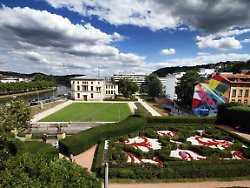Change of power after 20 years?
All data on the state elections in Saarland
03/26/2022, 8:34 p.m
Since 1999, the CDU has provided the prime minister in Saarland. But that could change with the state elections on March 27, 2022. The SPD is clearly ahead in the polls. All other parties have to worry about entering parliament. The data for the election at a glance.
It is the first major election decision in German politics in 2022: This Sunday there will be elections in Saarland. Around 800,000 voters are called upon to redefine the political balance of power in the Saarbrücken state parliament in the Federal Republic’s smallest area.
The state elections in Saarland are attracting a lot of attention nationwide: the vote in the Saar is the first major political decision in Germany since the 2021 federal elections last autumn. The Saar election is therefore more than just a state election. Observers also see the election as a first mood test for the red-yellow-green traffic light government in the federal government. And in Saarland, the political situation is in flux: there are signs of a change of government in the federal state with its 983,000 inhabitants.
A total of 17 parties and groups of voters are applying for the 51 seats in the Saarbrücken state parliament. The latest polls, however, predict a clear election victory for the SPD around challenger and state economics minister Anke Rehlinger. The CDU threatens to lose the government majority in the Saar.
The incumbent Prime Minister Tobias Hans – who only took over his post as head of state from Annegret Kramp-Karrenbauer in 2018 – has to fear for his re-election after just one term. At the beginning of March, the CDU politician tried a much-noticed one anger video turn things around about the gas prices at the gas station. But the video also brought him a lot of criticism. Shortly before the election, the incumbent had to go into isolation due to a corona infection.
The CDU state association has been confronted with declining poll numbers since the defeat of the Union in the federal elections in September. The state party could therefore in Saarland beat its worst election result of 33.4 percent from 1990 – the polls last saw it between 30 and 31 percent, after 40.7 percent in 2017.
Apart from the SPD, which has been part of the government in Saarland in a grand coalition since 2012, no other party has been able to benefit from the CDU’s downward trend. The Social Democrats achieve between 37 and 39 percent in the polls and could lead the state government again for the first time in 22 years.
With whom the Social Democrats could govern in the future is still completely open. The situation in Saarland is very different from that in federal politics: According to surveys, apart from the SPD and CDU, all other parties still have to worry about their entry into parliament.
And: With the exception of the FDP, the opposition parties inside and outside of parliament in Saarland are at odds. The Liberals around top candidate Angelika Hießerich-Peter have so far been seen at around five percent.
The left with top candidate Barbara Spaniol, currently still the largest opposition faction, is threatened with disaster after an escalated dispute over the top candidate in the federal elections and the end of his career, including the resignation of faction leader Oskar Lafontaine.
The left was only four percent in the polls – after a nationwide above-average result of 12.8 percent five years ago. Lafontaine’s spectacular withdrawal shortly before the election date is anything but helpful for Spaniol and her party – especially since Lafontaine made serious accusations against the left in his resignation statement. There was talk of a “creeping change in the political profile”, “manipulated lists of members” and support for a “fraud system established in Saarland”.
Things are hardly looking any better for the Greens in Saarland. Greens top candidate Lisa Becker found herself confronted with internal party disputes in the middle of the election campaign. The Greens in the Saar do not have an easy position anyway: due to a dispute over the state electoral list, the party was not eligible for a second vote in the federal election. In the polls, the Greens are seen at five to six percent. Before the dispute, it was up to 15 percent in polls.
The pollsters in Saarland trust the AfD with a result of up to six percent. This means that the alternatives could roughly keep their result from the past state election in 2017. This time, however, the AfD has to compete without its own state list: a list that had already been submitted was withdrawn shortly before the deadline, apparently without the knowledge of the state party leadership. The party is now dependent on the constituency lists of the three constituencies.
The 51 members of the Saarbrücken state parliament are elected for a regular legislative period of five years. As in the Bundestag elections, voting will take place under pandemic conditions. “Through their organizational precautions, the municipalities ensure compliance with the hygiene measures – which are now well known and generally practiced – both for postal voting in the rooms of the municipal administration and for ballot box voting in the polling stations on the day of the election,” said state returning officer Monika Zöllner in advance.
